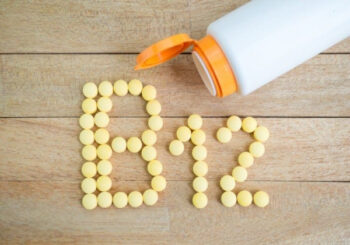By Sayer Ji
Contributing writer for Wake Up World
It’s all too common to assume that mass market vitamin manufacturers have your best interests at heart. Walking the aisles of pharmacy chains like Walgreens or CVS, you’ll notice hundreds if not thousands of ostensibly “natural products” in this category, and you may not think twice about what’s actually in these pleasantly dressed bottles.
[pro_ad_display_adzone id=”110028″]
But a quick peek down the rabbit hole of this subject will reveal that there is a distinctively dark side to the industry, especially supplement companies owned by the world’s largest pharmaceutical giants like Bayer. If you want background on this subject, read my article, Top Pharma-Brand of Children’s Vitamins Contains Aspartame, GMOs, & Other Hazardous Chemicals, wherein we discuss the children’s ‘vitamin’ known as Flinstones. It’s a trainwreck of a story.
One ingredient I left out in that exposé was the form of b12 used in nearly all mass market vitamins, namely, cyanocobalamin. So, I want to dedicate some time to the topic here now. Mind you, it’s a highly controversial topic, as there are plenty of natural and/or integrative health consultants and professionals who do not agree with my view. And perhaps they are correct. That said, discussion and dialog on the topic is always healthy, and the perspective and research presented below may help counterbalance the topic with an appopriate dose of nuance, and perhaps some caution.
Cyanide-Based b12 is the Most Common Form Used
Unknown to most consumers, cyanide is found in a wide range of vitamins and foods as a synthetic additive known as cyanocobalamin. Fortunately the cyanide has a very low potential to do harm because it is organically bound to cobalamin (vitamin b12) — that is, as long as everything is working correctly and that person hasn’t already been overburdened with environmental chemical exposures from cyanide, and related xenobiotic compounds that may interfere with their cyanide detoxifying pathways. Also, there are genetically-based differences in the ability of individuals to decyanate (remove the cyanide) cobalamin that has been identified to be mediated by a trafficking chaperone known as MMACHC. In fact, defects in MMACHC are believed to be the most common cause of inborn errors of b12 metabolism. Those who suffer from MMACHC-related dsyfunctions should be careful to only use cyanide-free forms such as aquacobalamin, hydroxocobalamin, or methylcobalamin.
Cyanocobalamin is actually found in the vast majority of the vitamins on the market which contain b12, as it is relatively cheap (recovered from activated sewage sludge or mammalian tissue with the addition of potassium cyanide or produced through total chemical synthesis), and relatively stable (non-perishable). Despite its wide usage, it is not an ideal form of vitamin b12, as the cyanide must be removed from the cobalamin before it can perform its biological indispensable roles within the body. While there is plenty of research on the potential value of cyanide-bound vitamin b12, and certainly vitamin B deficiency can have devastating adverse health effects, but it does have potential to do harm, and at the very least can not be considered superior to non-cyanide containing forms.
Is Cyanocobalamin Really A Health Concern?
In fact, when a person is poisoned with cyanide, as sometimes happens following smoke inhalation, and they are rushed to the emergency room, what do they give them to remove the cyanide? Hydroxocobalamin — a cyanide-free form of vitamin b12 — which readily binds with the cyanide, becoming cyanocobalamin, which sequesters the cyanide, putting it into a less toxic form that can be more readily eliminated from the body via the lungs and kidneys. You can learn more about this cyanide detoxification approach on Emergency Physician Monthly’s site here.

Those with a higher body burden or higher cyanide exposure, such as smokers, or those consuming large amounts of cassava, are less likely to be able to effectively detoxify the additional cyanide they consume through their diet or supplements, making the seemingly benign levels found in some vitamins and foods a real problem.
Indeed, this is not the first time the question of the potential toxicity of cyanocobalamin has been raised. As far back as 1992, a report was published in Journal of the Royal Society of Medicine arguing for its withdrawal from use in vitamin therapy, especially with smokers experiencing neuropathy. Another study published in 1997 in the journal Blood, found that cyanocobalamin “antagonizes vitamin B12 in vitro and causes cell death from methionine deficiency.”
[pro_ad_display_adzone id=”110030″]
Cyanide in non-vitamin form, of course, is extremely toxic and a poster child of sorts, among dangerous substances. It only takes 6.44 mg per kilogram, or 1.61 mg to kill 50% of your average-sized (500 gram) rats through the oral route of exposure. The margin of safety (as defined by the LD50) for cyanocobalamin, on the other hand, is approximately 1,000 times higher.
Interestingly, cyanocobalamin is listed as a hazardous air pollutant (HAP) generally known or suspected to cause serious health problems on the government’s toxicity database known as Toxnet. Moreover, according to Toxnet, “The Clean Air Act, as amended in 1990, directs EPA to set standards requiring major sources to sharply reduce routine emissions of toxic pollutants. EPA is required to establish and phase in specific performance based standards for all air emission sources that emit one or more of the listed pollutants. Cyanocobalamin is included on this list.”
There are two recent studies comparing the effects of cyanocobalamin to methylcobalamin in inflammatory bowel disease, showing the cyanide-based form may aggravate symptoms of bowel inflammation by shifting the microbiota towards a more inflammatory profile. This was demonstrated in both in an animal, and a human fecal sample, study.

Additional Ways to Obtain b12
There is an entirely different approach to maintaining adequate vitamin b12 levels, namely, through increasing populations of natural, vitamin b12-producing beneficial bacteria such as Lactobacillus reuteri. There has also been research showing that dietary contributions of b12 versus cyanocobalamin are far superior.
Significant dietary sources of biologically active b12 include white button mushrooms, spirulina and chlorella. The ideal supplemental form of supplemental vitamin b12 is methylcobalamin, which while more expensive, is capable of absorbing sublingually and is cell-ready as a methyl donor. It should also be noted that the drug category known as proton pump inhibitors (acid blockers for reflux) prevent vitamin b12 absorption and microwaving food deactivates this vitamin, as well.
Learn more about Vitamin b12 deficiency related disorders and ways to replenish B12 stores on the GreenMedInfo database: Vitamin b12 Deficiency.
About the author:
Sayer Ji is the founder of Greenmedinfo.com, a reviewer at the International Journal of Human Nutrition and Functional Medicine, Co-founder and CEO of Systome Biomed, Vice Chairman of the Board of the National Health Federation, and Steering Committee Member of the Global Non-GMO Foundation.
© 2020 GreenMedInfo LLC. This work is reproduced and distributed with the permission of GreenMedInfo LLC. Want to learn more from GreenMedInfo? Sign up for their newsletter here.
[pro_ad_display_adzone id=”110027″]








